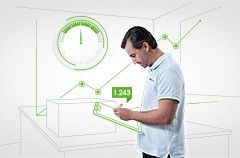
STARe Excellence Thermal Analysis Software
The Standard in Thermal Analysis
Our STARe software is the standard in thermal analysis, providing nearly limitless evaluation possibilities. Its unique features include modularity, flexibility and automation. The software also helps you to remain compliant within a regulated industry. All of our thermal analysis systems are controlled from one powerful software platform.
Advantages
Reliable Automation
Our TGA and DSC systems support fully automated workflows – from sample loading to result analysis and report generation. Up to 34 samples can be processed by our robust, factory endurance-tested sample robot.
Modular Concept
The STARe software consists of the base software and a large number of application-specific options. Owing to its modular design, STARe provides enormous flexibility, allowing users to incorporate new features based on their current and future requirements.

Unlimited Evaluation Possibilites
STARe is the benchmark for flexible evaluation. The software combines application-specific evaluation tools optimized for thermal analysis users with a superior layout program whose functionality sets no limits to individual creativity.

Integrated, Secure Database
The integrated database provides you with a clear overview of your all your thermal analysis data such as calibration data, evaluations and methods. Electronic records are securely stored and fully traceable with username, date and time stamps.

Simple Operation
STARe functionality is readily accessible from the software's intuitive ribbon interface. Standard features such as OneClick™ and multiple curve handling, as well as options like Quality Control and Reference Library, simplify daily lab work.

Solid Compliance
STARe software supports 21 CFR Part 11 compliance with password-protected application access, user rights for defined users by level, electronic records for file integrity, and properly logged audit trails and electronic signatures.

High-Level Competence & Support
Our global network of application specialists gives you access to the latest application know-how. Dedicated application specialists help to ensure that you obtain the most accurate thermal analysis results.
Explore Our Services - Tailored to Fit Your Equipment
According to the International Confederation for Thermal Analysis and Calorimetry (ICTAC), thermal analysis is group of techniques in which a physical property of a substance is measured as a function of temperature while the substance is subjected to a controlled temperature program.
Support & Repair

Training & Consulting

FAQs
How does thermal analysis software evaluate data?
Our thermal analysis software STARe is powerful and easy to use. Measurements and experiments are sent to the instruments, and the resulting curves can then be evaluated immediately based on the user’s wishes.
What is STARe software?
STARe sets the standard for thermal analysis software. It is an extremely versatile software that offers extreme flexibility and almost limitless evaluation possibilities. STARe is a comprehensive software that powers all of METTLER TOLDEO’s thermal analysis systems, further simplifying workflows. STARe software is continually being updated to ensure that the user experience and technology is the best it can be.
How easy is STARe to use?
STARe software is the ideal platform for any type of thermal analysis investigation – from simple experiments and automatic result evaluations from quality control to complex scientific applications used in research and academia.
The software’s five main windows make STARe simple and intuitive.
- Installation Window – allows you to set up instruments, create users and enter data concerning reference materials or other information relevant to the database.
- Module Control Window – represents the measuring modules that are connected. The window allows you to create simple methods and experiments for routine operation.
- Method Window – enables the creation of complex methods with an easy-to-use graphical interface.
- Experiment Window – starts experiments with all the relevant information.
- Evaluation Window – provides unlimited evaluation possibilities.
Can STARe software be tailored to the need of a user? Can it be expanded?
STARe software has a modular design, so the correct software package can be built and designed for a customer’s unique needs. The base software can be coupled with over 20 different application-specific software options to create a custom-tailored user experience. If the user’s needs change in the future, additional software options can easily be added.
What are the advanced features of STARe software?
STARe has some of the most powerful features on the market. These tools allow users to get the most of their systems.
- Integrated database – data is stored within the secure database by sample name, date and time.
- Reliable automation – improve efficiency with high sample throughput.
- Unlimited evaluation possibilities – provides enormous flexibility.
- Modular concept - STARe thermal analysis software consists of the base software and a large number of application-specific software options.
- Built for regulated industries - The 21 CFR part 11 operating mode incorporates additional security features stipulated by FDA regulations (electronic signature and audit trail).
- Time-saving FlexCal™ calibration – for more accurate measurement results.
What software options are available with STARe?
STARe has many different software options. Building the correct package depends on the user’s needs. The application software options are: DSC Evaluations, TGA Evaluations, TMA Evaluations, DMA Evaluations, MaxRes, Specific Heat, TOPEM™ (Multi-frequency TMDSC), Mathematics, Model Free Kinetics, Advanced Model Free Kinetics, Quality Control, Reference Library








